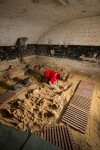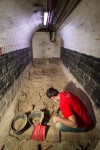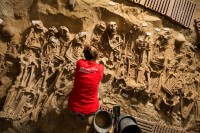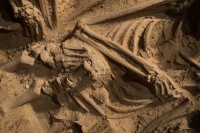 Archaeologists from France’s National Institute for Preventive Archaeological Research (INRAP) have discovered the skeletal remains of more than 200 individuals buried in eight mass graves under the basement of the Monoprix Réaumur-Sébastopol supermarket in Paris. The team was doing an archaeological survey in advance of construction and expected to encounter human remains because the building was known to have been constructed on the site of Trinity Hospital cemetery. The cemetery was in active use from the 12th century through the 17th and was destroyed at the end of the 18th. Its graves were excavated and bones transferred to the Paris catacombs in the second wave of transfers in 1843, then the Félix Potin grocery store was built on the site in 1860. That building was demolished and reconstructed in 1910. The current Monoprix store occupies the ground and first floor of that 1910 Art Nouveau building by architect Charles Lemaresquier.
Archaeologists from France’s National Institute for Preventive Archaeological Research (INRAP) have discovered the skeletal remains of more than 200 individuals buried in eight mass graves under the basement of the Monoprix Réaumur-Sébastopol supermarket in Paris. The team was doing an archaeological survey in advance of construction and expected to encounter human remains because the building was known to have been constructed on the site of Trinity Hospital cemetery. The cemetery was in active use from the 12th century through the 17th and was destroyed at the end of the 18th. Its graves were excavated and bones transferred to the Paris catacombs in the second wave of transfers in 1843, then the Félix Potin grocery store was built on the site in 1860. That building was demolished and reconstructed in 1910. The current Monoprix store occupies the ground and first floor of that 1910 Art Nouveau building by architect Charles Lemaresquier.
 So after centuries of disuse, revolution, a dedicated municipal program of bone collection and two buildings erected on the site, archaeologists had little expectation of discovering anything more that a few scattered bones. Instead they found well-organized and carefully laid-out mass graves. Seven of the graves contain between five and twenty bodies laid down in two to five layers. The eighth grave is much larger. So far the remains of more than 150 individuals have been unearthed in this one pit. They were deposited with exacting precision in five or six layers. At least two rows of the dead are placed head to toe. A third row appears to continue beyond the perimeters of the current excavation.
So after centuries of disuse, revolution, a dedicated municipal program of bone collection and two buildings erected on the site, archaeologists had little expectation of discovering anything more that a few scattered bones. Instead they found well-organized and carefully laid-out mass graves. Seven of the graves contain between five and twenty bodies laid down in two to five layers. The eighth grave is much larger. So far the remains of more than 150 individuals have been unearthed in this one pit. They were deposited with exacting precision in five or six layers. At least two rows of the dead are placed head to toe. A third row appears to continue beyond the perimeters of the current excavation.
“What is surprising is that the bodies were not thrown into the graves but placed there with care. The individuals – men, women and children – were placed head to toe no doubt to save space,” said archeologist Isabelle Abadie.
The bodies appear to have been buried all at the same time, which she said suggested they might have been the victims of the plagues which struck Paris in 14th, 15th and 16th centuries.
 Whatever mortality crisis struck — plague, other epidemics, famine — it struck wide. There are adults and children of all ages and both sexes buried in the largest mass grave. Initial examination of the bones has found no specific evidence of disease or injury. INRAP archaeologists will attempt to extract DNA samples for the bone which may reveal the presence of fatal pathogens. Other tests on the bones will determine their physical condition at death, if they were malnourished, if they had repetitive strain injuries from hard labor, etc. The remains will be radiocarbon dated to sort out which layers were deposited when.
Whatever mortality crisis struck — plague, other epidemics, famine — it struck wide. There are adults and children of all ages and both sexes buried in the largest mass grave. Initial examination of the bones has found no specific evidence of disease or injury. INRAP archaeologists will attempt to extract DNA samples for the bone which may reveal the presence of fatal pathogens. Other tests on the bones will determine their physical condition at death, if they were malnourished, if they had repetitive strain injuries from hard labor, etc. The remains will be radiocarbon dated to sort out which layers were deposited when.
 Researchers hope this excavation and the subsequent study will result in a more thorough understanding of how the living managed bodies in mass-death crises, a clearer picture of the spatial and temporal organization of the cemetery. The team will also study period sources and maps of Paris to find out more about the Trinity Hospital and its cemetery. It’s a rare opportunity to study such a site; fewer than a dozen mass burial sites in France have been subject to a thorough archaeological study, so there isn’t much scholarship on the subject and there is a great deal that remains unknown about funerary practices at cemeteries associated with medieval and early modern hospitals.
Researchers hope this excavation and the subsequent study will result in a more thorough understanding of how the living managed bodies in mass-death crises, a clearer picture of the spatial and temporal organization of the cemetery. The team will also study period sources and maps of Paris to find out more about the Trinity Hospital and its cemetery. It’s a rare opportunity to study such a site; fewer than a dozen mass burial sites in France have been subject to a thorough archaeological study, so there isn’t much scholarship on the subject and there is a great deal that remains unknown about funerary practices at cemeteries associated with medieval and early modern hospitals.
Once the study is complete, the state will claim the remains and arrange for reburial.